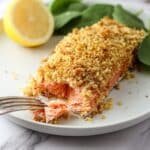Panko Crusted Salmon Recipe
This Panko Crusted Salmon recipe offers a deliciously crispy and flavorful twist on classic baked salmon. The salmon fillets are coated with a tangy Dijon mustard and melted butter mixture, then topped with toasted panko breadcrumbs flavored with fresh lemon zest. Baked to perfection, this dish is a quick and elegant main course ideal for busy weeknights or special occasions.
- Prep Time: 10 minutes
- Cook Time: 10 minutes
- Total Time: 20 minutes
- Yield: 4 servings
- Category: Main Course
- Method: Baking
- Cuisine: American
- Diet: Low Fat
Ingredients
Salmon
- 4 6-ounce salmon fillets
- ½ teaspoon salt
- ¼ teaspoon pepper
Mustard Coating
- 2 tablespoons Dijon mustard
- 1 tablespoon unsalted butter, melted
Panko Topping
- ½ cup panko bread crumbs
- 1 teaspoon lemon zest
Instructions
- Preheat the Oven: Preheat your oven to 425℉ and line a baking sheet with parchment paper to prevent sticking and make cleanup easier.
- Prepare the Salmon: Place the salmon fillets on the prepared baking sheet, spacing them about 2 inches apart, with the skin side facing down to ensure even cooking.
- Make Mustard Mixture: In a small bowl, combine the Dijon mustard, melted butter, salt, and pepper. Stir well to create a smooth sauce. Spoon this mixture evenly over each salmon fillet and spread it into a thin, uniform layer.
- Toast the Panko: Heat a skillet over medium heat and add the panko breadcrumbs. Toast, stirring frequently, until they turn golden brown and fragrant, about 3-4 minutes. Remove from heat and stir in the lemon zest to infuse a bright citrus flavor.
- Apply Panko Crust: Sprinkle the toasted panko mixture evenly over the mustard-coated salmon fillets. Press down gently so the panko adheres well to the mustard layer, creating a crisp crust.
- Bake the Salmon: Place the baking sheet in the preheated oven and bake for 10-12 minutes, depending on thickness. The salmon is done when it flakes easily with a fork or reaches an internal temperature of 125–145℉ depending on your preference.
Notes
- Pin bones: Before cooking, check each salmon fillet for pin bones by gently running your fingers over the surface. Use pliers to carefully remove any bones you find to avoid any surprise bites.
- Testing for doneness: A meat thermometer ensures perfect cooking—USDA recommends 145℉ but many prefer 125℉ for a moister texture. Alternatively, check if the salmon flakes apart easily with a fork.
- Leftovers: Store any leftover salmon in an airtight container in the refrigerator for 3 to 4 days for best freshness.
Find it online: https://cookingwithsarah.com/panko-crusted-salmon-recipe/

